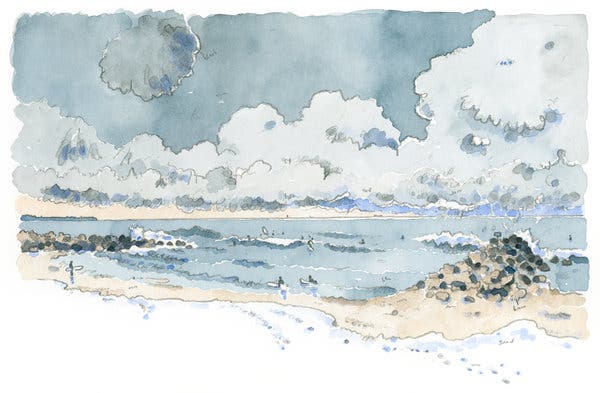Advertisement
On an icy break at the end of a subway line in Queens, freezing waves don’t deter the die-hards. For the hardiest, a wet suit is optional.

Text and Illustrations by Elisha Cooper
First light. Two figures stand on the boardwalk and scan the break. They look over a beach bleached of color, past wind-tattered WARNING flags, out to where waves are shattering against rock jetties. Then the two pick up their boards and shuffle across the snow and the sand and into the water, in a hurry to join the line of surfers bobbing offshore.
The winter season at Rockaway Beach, with its big waves and storm-fueled swells, attracts a devoted breed of surfer. The kind who wakes before dawn, who battles the A train, who navigates turnstiles with a surfboard, who — when the waves are right — will even surf in a gale.
Surfers change into their wetsuits on the boardwalk. (To do so anywhere but at the beach is frowned upon.) With only faces exposed, they look like seals in various states of physical fitness.
Chris Williams strips out of his clothes, but keeps his winter hat on. He’s a nursing student, and didn’t have class this morning. So he went surfing.
“I’m not very good,” he laughs, his breath pluming the air. But Williams appreciates the Rockaways, how it’s both peaceful and wild. And close.
Williams tugs on his wetsuit (winter suits are five millimeters thick and cumbersome). Then boots, hood, gloves. The technology makes winter surfing seem not so crazy, or so cold. Still, Williams says, that first slap of icy ocean water to the face is brutal. And it’s hard afterward, on the subway, trying to tie your shoes.
Some days the waves are a mess, but that doesn’t stop Cindy Lai.
If you don’t learn how to surf lousy waves, she says, dropping in an unprintable adjective, “how are you going to learn?” The waves today are definitely unprintable. Ugly, chaotic, formless, mean.
Lai leans into the wind and stares at the water. Beach foam whips at her ankles. After tucking her hair into her hood, she stretches: shoulder rolls, rotational lunges, side lunges with a twist. She’s a personal trainer in Chelsea.
She says she meditates on the subway ride here; when she’s in the ocean, her mind is free. Lai paddles into the waves; they push her back.
“Unfriendly!” she shouts, her voice buffeted by the wind, the smile on her face intact. Lai retreats, moves down the beach, tries again. Ten minutes later she is still trying to get out past the waves but they won’t let her.
After days of gnarly waves, the weather switches. Thick waves curl evenly to shore with a low rumble. Twenty surfers float outside the break, waiting. A wave rears up. One surfer tips forward and face-plants, board flipping skyward in a white polyurethane flag of surrender.
Another wave rises up. Another surfer leaps up and cuts down the face of it, knees bent, arms low, gaining balance, leaving behind a crash of white, gathering speed as time slows, as wave and surfer shoot from one side of the break all the way to the other until finally the wave eases and the surfer drops. In that moment, despite this taking place at a distance, the language spoken within that body is clear: euphoria.
A morning frost covers the beach. Dune grasses shiver. This doesn’t stop the regulars. One man has been coming to the beach and bodysurfing. Without a wetsuit. He catches the waves inside the surfers and rides them to shore, a bare-chested bald torpedo. He stays out there an impossibly long time (the water temperature is 42 degrees) before coming in and running around the sand in tight little circles. He towels off, skin steaming. Drinks from a thermos. Pulls on pants, socks, multiple sweaters, a scarf. Clothed, he looks like a normal New Yorker.
Warren Sampson doesn’t love surfing in the cold. He grew up in the Rockaways, but learned to surf in Jamaica. After serving 12 years in the Marines, he’s now in school and works at Breakwater Surf Co. He also started a nonprofit school where he and his cousin teach surfing to local children. But that’s in good weather.
“You have to fight through it,” Sampson says of winter surfing. He mutters something about mental fortitude, then paddles out to the break.
Sampson catches a few waves. A few waves catch him, flipping him around like he’s not 200 pounds and built like an anchor, which he is. Thirty minutes later Sampson returns to shore, sore and breathless. He’s beaming: “I’m done!”
Rockaway Beach, even in winter, is always in flux: waves, clouds, creatures. Nothing stays in one place for long. Sandpipers racing, sea gulls hovering, snow geese rolling over waves (they almost look as if they’re surfing). Dawn sky sliding from pink to gray. Container ships scud the horizon. Overhead, a winged leviathan, Japan Airlines Flight 006 from Tokyo, breaks through the clouds and descends toward John F. Kennedy Airport. A line of surfers floats offshore, waiting.
“I need this,” Steve Horney says as he scans the break. It’s a crisp morning, with small waves. Horney has the beach to himself.
Discovering the Rockaways changed Horney’s perspective on living in New York. He’s a physical therapist in the West Village; he has come out as often as he can this winter. After surfing he’ll go to Locals, the cafe and surf collective where he rents a locker to store his boards. He’ll have a hot shower and an herbal tea before riding the A train home. But not yet.
“There’s really something special about right here, right now,” he says. He tucks his beard into his hood. Stretches his legs, arms, core. Then he walks into the surf, lifts himself onto his board, and paddles out into the ocean.
Elisha Cooper is an author and illustrator of children’s books.





Recent Comments